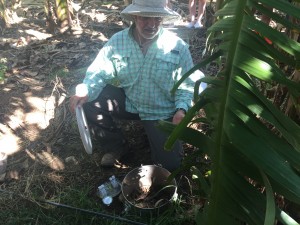Visiting farms is one of the most exciting part of the journey for me. It is planned and designed to enhance our understanding about agricultural sustainability. During the second week of the trip, Dr. Rodriguez brought us to several coffee and fruit farms around the island.
The first farm we visited was Hacienda Buena Vista up in the mountain. It is no longer in operation but it is preserved as a historical site where people are welcomed to learn coffee production and agricultural conservation. During the trip, I learnt to distinguish coco trees and cacao trees and the mechanics involved in coffee production. Coffee beans are peeled off from the outer layers by a machine using friction, and are consequently grinded using the grinding machine powered by hydraulic power. The grinding machine was specially designed for the farm, and there is only one such machine in the world. To ensure ample water supply in the farm, water is channeled from mountain down to the farm with an elevation about a thousand feet. As we were climbing up to the high end of the farm, we came across a few small entries by the water channel, and the guide told us that those were designed for child slaves to get in and clear the roots and soil that clogged the water channel. Slaves were commonly involved in agriculture activities and provided cheap labor service during old time in Puerto Rico. Enslavement is no longer exist today, but labor has become an expensive resource today.
On the visit of the second coffee farm—Café Gran Batey in Utuado, I learnt about more issues related to Puerto Rican agriculture. This farm is one of the major coffee producer for the local market. Different from Hacienda Buena Vista, it does not have large canopy of trees to provide shading for coffee trees, so the farm grows citrus trees next to coffee trees to create artificial shades. The purpose of the shade does not only reduce the extent of sunlight but lengthens the growth period for better quality coffee. When the coffee beans reap, the farm hires local workers to pick them. The owner of the farm told us that it is difficult to hire workers to pick coffee beans nowadays because local labors need less incentive to work with the unemployment welfare from the state. On average, those workers work for three to four hours a day in mornings. As compared to other parts of the U.S, agricultural industry in Puerto Rico is more dependent on human labors given the different types of crops grown and geographical challenges in Puerto Rico. Automation and large off-road machineries are not as applicable in fruit plantations as in flat corn fields. Unfortunately, less people among the younger generation are willing to work on farms, and the agricultural industry that thrived Puerto Rican economy is now in a decline. To help the agricultural industry be more efficient and economic, traditional agriculture that is labor intensive is expected to shift to machinery-led modern agriculture. Besides labor, agricultural activities are also highly depended on weather. Last year, the overall coffee production reached an all-time low and fell short of the local coffee demand because of the off rain and dry season. Although agricultural engineering can help farmers in many ways, there is a limit when it comes to the nature. At the end of the trip, we sipped in a cup of coffee accompanied with a piece of pound cake in the mountain. It was an very enjoyable experience!
After learning about coffee production, we had a chance to study nutrient loss in plantain farm and visit the packaging factory in Matex fruit farm. In the plantain field, Dr. Perez who is an Agricultural and Biological Engineering professor in the Mayaguez University introduced us the method to detect the nitrogen concentration in the soil and air. The purpose of the project he is leading is aimed to help plantain farmers find the most sustainable recipe for the plants and surroundings. From this experience, I realized the importance of agricultural and biological engineering in the society as it helps to solve and improve the most primary and fundamental industry in the world — agricultural industry. After watching the demonstration of collecting air samples, we headed to the package factory in the farm. All the plantains are consumed locally but fruits like mangoes and Spanish lemons are exported to other parts of America and European countries for higher profits. The farm also installed a lot of solar panels were installed with the help of government funding, such action promotes sustainability and reduces electricity bill in operation. From the farm manager, we learnt that the farm has been operating for twenty seven years, but it took five to ten years to start making profits. It really takes a lot of capital and determination to start up a farm. Agricultural industry is primary but it is not necessarily lucrative. Regardless, I hope more young people will step into agriculture with more help and encouragement from the state and the older generation.



